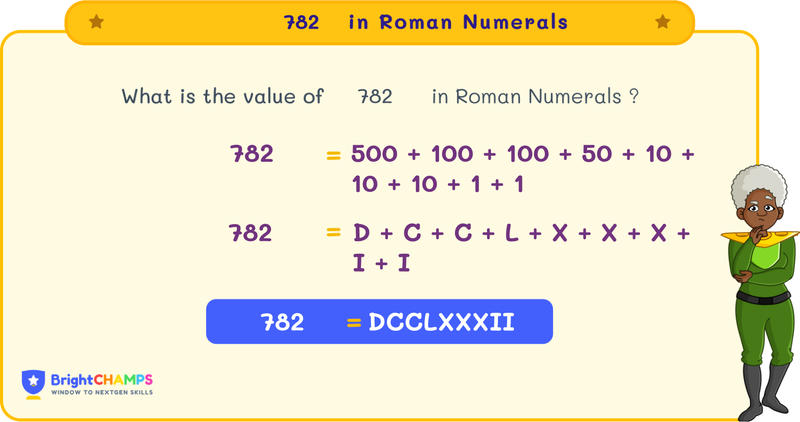


 136 Learners
136 LearnersLast updated on May 26th, 2025

782 in Roman Numerals

Roman numerals are a way of expressing numbers using symbols. I, V, X, L, C, D, and M are the symbols we use. Roman numerals are used in royal titles, book names, sequences, and so on. Here we will be discussing Roman numerals, rules, and examples.
What is 782 in Roman Numerals?
The royal titles, such as Henry I, Henry II, and so on, have you noticed the names and wondered what these symbols (I and II) represented? Those are the Roman numerals.
Earlier, people used to count using fingers, sticks, bones, etc. When life became complex, a standard form was required to count. Ancient Romans used the Roman numeral system to count. I (1), V (5), X (10), L (50), C (100), D (500), and M (1000) are the symbols we use to count.
In Roman numerals, we use DCCLXXXII to represent 782, where D is 500, C is 100, L is 50, X is 10, and I is 1. Let’s learn more about Roman numerals and how we write them.

Basic Rules for 782 in Roman Numerals
There are certain basic rules to write a number in Roman numerals. In this section, let’s discuss some basic rules that need to be remembered when writing a number in Roman numerals.
Rule 1: Addition Method
The addition method is used when the smaller number is placed after the larger number. For example, DCCLXXXII → D + C + C + L + X + X + I + I → 500 + 100 + 100 + 50 + 10 + 10 + 1 + 1 = 782
Rule 2: Repetition Method
To write a large number, certain Roman numerals can be repeated three times. III → 3.
Rule 3: Subtraction Method
If a small number is followed by a large number in Roman numerals, we subtract the smaller number from the large number. For example, IX → X - I → 10 - 1 = 9
Rule 4: Limitation Rule
The symbols cannot be repeated more than three times, and some symbols like V, L, and D cannot be repeated. For example, we won't write VV for 10; instead, we use X, and 8 is written as VIII, not IIIIIIII.
How to Write 782 in Roman Numerals
Let’s now learn how to write 782 in Roman numerals. Follow these methods to write the number in Roman numerals.
- By Expansion Method
- By Grouping Method
782 in Roman Numerals by Expansion Method
In the expansion method, based on the place value, the number is broken down. In this section, we will learn how to write 782 in Roman numerals using the expansion method. To write 782 in Roman numerals, follow the steps:
Step 1: The number is broken based on the place value: hundreds, tens, ones, etc. For 782, we write it as 700 + 80 + 2.
Step 2: Converting the number into Roman numerals:
- 700 in Roman numerals - DCC
- 80 in Roman numerals - LXXX
- 2 in Roman numerals - II
Step 3: Combining the Roman numerals together. Therefore, 782 in Roman numerals is DCC (700) + LXXX (80) + II (2) = DCCLXXXII
782 in Roman Numerals by Grouping Method
When writing a large number into Roman numerals, we group the number. To write 782 in Roman numerals, we group 782 as 700 + 80 + 2.
- 700 in Roman numerals - DCC
- 80 in Roman numerals - LXXX
- 2 in Roman numerals - II
So, 782 is written as DCCLXXXII in Roman numerals.

Common Mistakes and How to Avoid Them in 782 Roman Numerals
Students make mistakes when writing a number in Roman numerals. To master Roman numerals, we can learn a few common mistakes and the ways to avoid them.

782 in Roman Numerals Examples

Problem 1
Calculate the quotient of DCCCXXII divided by II.

The quotient of DCCCXXII divided by II is CDXI.
Explanation
DCCCXXII is 822 in Roman numerals, and II is 2.
The division of 822 by 2 equals 411.
Thus, 411 in Roman numerals is CDXI.

Problem 2
A historian found a scroll with DCCLXXXII pages and wants to divide it equally over XXXIX sections. How many pages will each section contain?

Each section will contain XX pages.
Explanation
DCCLXXXII equals 782 in Roman numerals, and XXXIX is 39.
Dividing 782 by 39 gives 20.
In Roman numerals, 20 is XX.

Problem 3
A collection has DCCXXX and LII artifacts. What is the total number of artifacts in Roman numerals?

The total number of artifacts is DCCLXXXII.
Explanation
DCCXXX equals 730, and LII equals 52.
The sum of 730 and 52 equals 782.
Therefore, 782 in Roman numerals is DCCLXXXII.

Problem 4
What is the Roman numeral representation of the difference between DCCC and XVIII?

The difference between DCCC and XVIII is DCCLXXXII.
Explanation
DCCC is 800 in Roman numerals, and XVIII is 18.
Subtracting 18 from 800 gives 782.
Thus, 782 in Roman numerals is DCCLXXXII.

Problem 5
Express the sum of CCCXC and CCCXCII using Roman numerals.

The sum of CCCXC and CCCXCII is DCCLXXXII.
Explanation
CCCXC equals 390, and CCCXCII equals 392.
Adding 390 and 392 gives 782.
Therefore, 782 in Roman numerals is DCCLXXXII.


FAQs on 782 in Roman Numerals
1.What is 9 in Roman numerals?
2.How to write 782 in Roman numerals?
3.What is 16 in Roman Numerals?
4.Is DCCLXXXII a prime number?
5.What are the multiples of 782?
Important Glossaries for 782 in Roman Numerals
- Addition rule: The addition method is used when a large number is followed by a smaller numeral. Here, the values are added. For example, DCCLXXXII = D (500) + CC (200) + L (50) + XXX (30) + II (2) = 782
- Grouping method: Here, the given numbers are grouped based on their place value, and then we convert each group into its Roman numerals. For example, 782 = 700 + 80 + 2 = DCCLXXXII
- Repetition rule: Certain symbols (I, X, C, M) in the Roman numeric system can be repeated only up to three times. For example, III = 3 (I is repeated three times to represent the number 3).
- Subtraction rule: The subtraction method is used when a smaller numeral precedes a larger numeral, indicating subtraction of the smaller from the larger. For example, IX = X - I = 9
- Roman numeral symbols: The key symbols in the Roman numeral system are I (1), V (5), X (10), L (50), C (100), D (500), and M (1000).
Explore More numbers
 Previous to 782 in Roman Numerals
Previous to 782 in Roman Numerals


Hiralee Lalitkumar Makwana
About the Author
Hiralee Lalitkumar Makwana has almost two years of teaching experience. She is a number ninja as she loves numbers. Her interest in numbers can be seen in the way she cracks math puzzles and hidden patterns.

Fun Fact
: She loves to read number jokes and games.



